Multi-Scale Assessment and Spatio-Temporal Interaction Characteristics of Ecosystem Health in the Middle Reaches of the Yellow River of China
Abstract
:1. Introduction
2. Materials and Methods
2.1. Materials
2.2. Methods
2.2.1. Framework of Ecosystem Health Assessment
2.2.2. Ecosystem Health Assessment Based on the Improved VORS Method
2.2.3. Optimal Analysis Scale Selection Based on Semi-Variogram
2.2.4. Variation Coefficient, Theil Index and Theil Decomposition Index
2.2.5. Exploratory Space–Time Data Analysis Method
3. Results
3.1. Optimal Analysis Scale of Ecosystem Health
3.2. Spatio-Temporal Characteristics of Ecosystem Health
3.2.1. Time Series Evolution
3.2.2. Spatial Pattern Evolution
3.3. Spatio-Temporal Interaction Characteristics of Ecosystem Health
3.3.1. LISA Time Path Analysis
3.3.2. LISA Space-Time Transition Analysis
3.3.3. Spatio-Temporal Networks of Ecosystem Health Interactions
4. Discussion
4.1. The Improved VORS Method
4.2. The Analytical Scale
4.3. Spatio-Temporal Interactions Networks
4.4. Future Research Direction
5. Conclusions
- (1)
- From 1990 to 2018, the ecosystem health level at grid and county scale in the MRYR showed a trend of first decline and then increase, and experienced a slow decline and a steady rise from 1990 to 2005 and 2005 to 2018, respectively. The regional difference of ecosystem health was large, and it increased first and then decreased in time series. In terms of spatial pattern, the ecosystem health level at grid and county scale presented a spatially hierarchical structure with alternating low-value and high-value zones.
- (2)
- In terms of scale effects of ecosystem health, the inter-group differences in the eastern, central, and western regions showed differences at grid and county scales, i.e., the temporal change in inter-group differences at grid scale was relatively stable compared with that at county scale. Compared with the county scale, the grid scale can describe the spatial distribution characteristics of ecosystem health more refined, indicating the existence of spatial scale effects in ecosystem health assessment.
- (3)
- In terms of spatio-temporal interaction characteristics, the period from 1990 to 2010 was in the strong interaction period, and the period from 2010 to 2018 was in the weak interaction period. The rapid urbanization areas, the ecologically fragile areas in the central and western regions and the transitional zone between mountain and basin have more dynamic spatial structure and stronger spatio-temporal interaction process. The boundary between the northwest low-value zone and the central high-value zone, the central part of the northern Shaanxi Plateau and the rapid urbanization area are dominated by the spatial spillover effect, while the transitional zone between plain and mountain area is dominated by the spatial polarization effect.
- (4)
- In terms of spatio-temporal interaction network, the regional system is mainly growing or decreasing cooperatively in the evolution process. Locally, there were strong spatio-temporal competition in the process of time evolution in six typical regions, such as the surrounding areas of provincial capitals, the fringe areas of cities, the transitional zone between mountainous and basin in the central and western regions, the transitional zone of ecologically fragile regions, the mountainous areas of western Henan Province, and the areas along rivers. In addition, the rapid urbanization areas in the mid-east region, the transitional zone between mountains and plains in the east region, and the marginal zone of the Loess Plateau gradually tend to exhibit spatio-temporal competition.
Supplementary Materials
Author Contributions
Funding
Institutional Review Board Statement
Informed Consent Statement
Data Availability Statement
Acknowledgments
Conflicts of Interest
References
- Li, Y.; Qin, Y.C.; Rong, P.J. Evolution of potential evapotranspiration and its sensitivity to climate change based on the Thornthwaite, Hargreaves, and Penman–Monteith equation in environmental sensitive areas of China. Atmos. Res. 2022, 273, 106178. [Google Scholar] [CrossRef]
- Xiao, Y.; Guo, L.; Sang, W.G. Impact of Fast Urbanization on Ecosystem Health in Mountainous Regions of Southwest China. Int. J. Environ. Res. Public Health 2020, 17, 826. [Google Scholar] [CrossRef] [PubMed] [Green Version]
- Mamun, M.; Kim, J.E.; An, K.G. Land Cover and Human Disturbance Impact on Water Chemistry and Ecological Health in an Asian Temperate Lotic System. Land 2022, 11, 1428. [Google Scholar] [CrossRef]
- Li, W.J.; Wang, Y.; Xie, S.Y.; Cheng, X. Coupling coordination analysis and spatiotemporal heterogeneity between urbanization and ecosystem health in Chongqing municipality, China. Sci. Total Environ. 2021, 791, 148311. [Google Scholar] [CrossRef] [PubMed]
- Chase, J.M.; Blowes, S.A.; Knight, T.M.; Gerstner, K.; May, F. Ecosystem decay exacerbates biodiversity loss with habitat loss. Nature 2022, 584, 238–262. [Google Scholar] [CrossRef]
- Zhang, L.; Huang, J.P.; Liang, J.Y. Impact of climate change on the Yellow River basin and response. Sci. Technol. Rev. 2020, 38, 42–51. [Google Scholar]
- Zhou, S.; Wang, Y.M.; Guo, A.J.; Zhang, R.H. Spatial and temporal features of future changes in water resources in Yellow River basin. J. Hydrol. Eng. 2018, 37, 28–39. [Google Scholar]
- Hu, Y.F.; Zhang, Y.Z.; Han, Y.Q. Identification and monitoring of desertification lands in China from 2000 to 2015. Arid. Land. Geogr. 2018, 41, 1321–1332. [Google Scholar]
- Lu, Y.L.; Yang, Y.F.; Sun, B. Spatial variation in biodiversity loss across China under multiple environmental stressors. Sci. Adv. 2020, 6, eabd0952. [Google Scholar] [CrossRef]
- Peter, S. Comprehensive Analytical Study of the Greenhouse Effect of the Atmosphere. Atmos. Clim. Sci. 2020, 10, 40–80. [Google Scholar]
- Huang, C.; Liu, G.H.; Wang, X.G. Monitoring wetlands pattern in the Yellow River Basin for water resources management using Beijing-1 images. Geogr. Res. 2012, 31, 1764–1774. [Google Scholar]
- Zhang, K.; Lv, Y.H.; Fu, B.J.; Yi, L.C.; Yu, D.D. The effects of vegetation coverage changes on ecosystem service and their threshold in the Loess Plateau. Acta. Geogr. Sin. 2020, 75, 949–960. [Google Scholar]
- Haddad, N.M.; Brudvig, L.A.; Clobert, J. Habitat fragmentation and its lasting impact on Earth’s ecosystems. Sci. Adv. 2015, 1, e1500052. [Google Scholar] [CrossRef] [Green Version]
- Xu, X.R.; Xu, Y. Analysis of spatial-teporal variation of human activity intensity in Loess Plateau region. Geogr. Res. 2017, 36, 661–672. [Google Scholar]
- Li, Y.; Li, M.D.; Zheng, Z.C.; Shen, W.; Li, Y.N.; Rong, P.J.; Qin, Y.C. Trends in drought and effects on carbon sequestration over the Chinese mainland. Sci. Total Environ. 2023, 856, 159075. [Google Scholar] [CrossRef]
- Luo, Y.; Sun, W.Z.; Yang, K.; Zhao, L. China urbanization process induced vegetation degradation and improvement in recent 20 years. Cities 2021, 114, 103207. [Google Scholar] [CrossRef]
- Tian, H.F.; Qin, Y.C.; Niu, Z.; Li, W. Summer Maize Mapping by Compositing Time Series Sentinel-1A Imagery Based on Crop Growth Cycles. J. India. Soc. Remote Sens. 2021, 49, 2863–2874. [Google Scholar] [CrossRef]
- Peng, J.; Liu, Y.X.; Li, T.Y.; Wu, J.S. Regional ecosystem health response to rural land use change: A case study in Lijiang City, China. Ecol. Indic. 2017, 72, 399–410. [Google Scholar] [CrossRef]
- He, J.H.; Pan, Z.Z.; Liu, D.F.; Guo, X.N. Exploring the regional differences of ecosystem health and its driving factors in China. Sci. Total Environ. 2019, 673, 553–564. [Google Scholar] [CrossRef]
- Shen, W.; Zheng, Z.C.; Qin, Y.C.; Li, Y. Spatiotemporal Characteristics and Driving Force of Ecosystem Health in an Important Ecological Function Region in China. Int. J. Environ. Res. Public Health 2020, 17, 5075. [Google Scholar] [CrossRef]
- Shen, W.; Zheng, Z.C.; Pan, L.; Qin, Y.C.; Li, Y. A integrated method for assessing the urban ecosystem health of rapid urbanized area in China based on SFPHD framework. Ecol. Indic. 2021, 121, 107071. [Google Scholar] [CrossRef]
- Pan, Z.Z.; He, J.H.; Liu, D.F.; Wang, J.W. Predicting the joint effects of future climate and land use change on ecosystem health in the Middle Reaches of the Yangtze River Economic Belt, China. Appl. Geogr. 2020, 124, 102293. [Google Scholar] [CrossRef]
- Su, M.R.; Xie, H.; Yue, W.C.; Zhang, L.X.; Yang, Z.F.; Chen, S.H. Urban ecosystem health evaluation for typical Chinese cities along the Belt and Road. Ecol. Ind. 2019, 101, 572–582. [Google Scholar] [CrossRef]
- Sun, T.T.; Lin, W.P.; Chen, G.S.; Guo, P.P.; Zeng, Y. Wetland ecosystem health assessment through integrating remote sensing and inventory data with an assessment model for the Hangzhou Bay, China. Sci. Total Environ. 2016, 566, 627–640. [Google Scholar] [CrossRef] [PubMed]
- Ji, X.M.; Tao, Z.M.; Chen, J.H.; Cheng, Y.Q.; Fu, Y.Q. Space-time interaction of provincial inequality of international tourism in China: The comparison between main tourist markets. Geogr. Res. 2016, 35, 363–376. [Google Scholar]
- Zhang, Y.; Xu, J.H.; Zhuang, P.J. The spatial relationship of tourist distribution in Chinese cities. Tourism Geographies 2011, 13, 75–90. [Google Scholar] [CrossRef]
- Jin, G.; Deng, X.Z.; Dong, Y.; Wu, F. China’s multidimensional poverty measurement and its spatiotemporal interaction characteristics in the perspective of development geography. Acta. Geogr. Sin. 2020, 75, 1633–1646. [Google Scholar]
- Tian, H.F.; Chen, T.; Li, Q.Z.; Mei, Q.Y.W.; Wang, S. A Novel Spectral Index for Automatic Canola Mapping by Using Sentinel-2 Imagery. Remote Sens. 2022, 14, 1113. [Google Scholar] [CrossRef]
- Wang, Q.L.; Chen, G.; Dai, L.M. Ecosystem Health—Theory and Practice; Liaoning Science & Technology Press Publishing House: Shenyang, China, 2007. [Google Scholar]
- Costanza, R. Ecosystem health and ecological engineering. Ecol. Eng. 2012, 45, 24–29. [Google Scholar] [CrossRef]
- Xiao, R.; Liu, Y.; Fei, X.F.; Yu, W.X.; Zhang, Z.H.; Meng, Q.X. Ecosystem health assessment: A comprehensive and detailed analysis of the case study in coastal metropolitan region, eastern China. Ecol. Ind. 2019, 98, 363–376. [Google Scholar] [CrossRef]
- Kang, P.; Chen, W.P.; Hou, Y.; Li, Y.Z. Linking ecosystem services and ecosystem health to ecological risk assessment: A case study of the Beijing-Tianjin-Hebei urban agglomeration. Sci. Total Environ. 2018, 636, 1442–1454. [Google Scholar] [CrossRef]
- Liu, D.L.; Hao, S.L. Ecosystem health assessment at county-scale using the pressure-state-response framework on the Loess Plateau, China. Int. J. Environ. Res. Public Health 2017, 14, 2. [Google Scholar] [CrossRef] [Green Version]
- Li, J.; Shen, W. Spatial heterogeneity of the effects of human activities on ecosystem health of a coastal tourism city—A case study of Rizhao, China. Appl. Ecol. Environ. Res. 2021, 19, 3029–3051. [Google Scholar] [CrossRef]
- Li, W.J.; Xie, S.Y.; Wang, Y.; Huang, J.; Cheng, X. Effects of urban expansion on ecosystem health in Southwest China from a multi-perspective analysis. J. Clean. Prod. 2021, 294, 126341. [Google Scholar] [CrossRef]
- Shi, Y.; Han, R.; Guo, L. Temporal Spatial Distribution of Ecosystem Health and Its Response to Human Interference Based on Different Terrain Gradients: A Case Study in Gannan, China. Sustianability 2020, 12, 1773. [Google Scholar] [CrossRef] [Green Version]
- Li, X.J.; Qiao, J.J. County Level Economic Disparities of China in the 1990s. Acta. Geogr. Sin. 2001, 56, 136–145. [Google Scholar]
- Yan, T.; Zhang, X.P.; Chen, H.; Li, R.K. Evolution of Regional Differences in Urban Economic Development in China from 2001 to 2016. Econ. Geogr. 2019, 39, 11–20. [Google Scholar]
- Shi, L.J.; Liu, M.; Li, Y.P.; Zhang, X.L.; Gao, F.; Li, W.G. The spatio-temporal evolution and influencing factors of economic difference at county level in Fenhe River Basin. Geogr. Res. 2020, 39, 2361–2378. [Google Scholar]
- Costanza, R.; Groot, R.; Sutton, P. Changes in the global value of ecosystem services. Global Environ. Chang. 2014, 26, 152–158. [Google Scholar] [CrossRef]
- Costanza, R.; De Groot, R.; Braat, L. Twenty years of ecosystem services: How far have we come and how far do we still need to go? Ecosyst. Serv. 2017, 28, 1–16. [Google Scholar] [CrossRef]
- Xie, G.D.; Zhang, C.X.; Zhen, L.; Zhang, L.M. Dynamic changes in the value of China’s ecosystem services. Ecosyst. Serv. 2017, 26, 146–154. [Google Scholar] [CrossRef]
- Bagstad, K.J.; Johnson, G.W.; Voigt, B.; Villa, F. Spatial dynamics of ecosystem service flows: A comprehensive approach to quantifying actual services. Ecosyst. Serv. 2013, 4, 117–125. [Google Scholar] [CrossRef]
- Sun, W.Y.; Shao, Q.Q.; Liu, J.Y. Assessment of Soil Conservation Function of the Ecosystem Services on the Loess Plateau. J. Nat. Res. 2014, 29, 365–376. [Google Scholar]
- Ramzan, S.; Wani, M.A.; Bhat, M.A. Assessment of Spatial Variability of Soil Fertility Parameters Using Geospatial Techniques in Temperate Himalayas. Int. J. Geosci. 2017, 8, 1251–1263. [Google Scholar] [CrossRef] [Green Version]
- Yang, K.; Xin, G.X.; Jiang, H.Y.; Yang, C.X. Study on Spatiotemporal Changes of Landscape Ecological Risk Based on the Optimal Spatial Scale: A Case Study of Jiangjin District, Chongqing City. J. Ecol. Rural Environ. 2021, 37, 576–586. [Google Scholar]
- Zhou, K.; Fan, J. Regional disparity of environmental pollution source and its socio-economic influencing factors: Based on the cross-section data of 339 cities at prefecture level or above in China. Acta Geogr. Sin. 2016, 71, 1911–1925. [Google Scholar]
- Zhao, X.Y.; Wang, W.J.; Wan, W.Y. Regional differences in the health status of Chinese residents:2003–2013. J. Geogr. Sci. 2017, 28, 741–758. [Google Scholar] [CrossRef] [Green Version]
- Pan, W.B.; Fu, H.M.; Zheng, P. Regional Poverty and Inequality in the Xiamen-Zhangzhou-Quanzhou City Cluster in China Based on NPP/VIIRS Night-Time Light Imagery. Sustainability 2020, 12, 2547. [Google Scholar] [CrossRef] [Green Version]
- Ye, X.Y.; Rey, S. A framework for exploratory space-time analysis of economic data. Ann. Regional. Sci. 2013, 50, 315–339. [Google Scholar] [CrossRef]
- Anselin, L. Local indicators of spatial association: LISA. Geogr. Anal. 1995, 27, 93–115. [Google Scholar] [CrossRef]
- Hao, S.; Sun, C.Z.; Song, Q.M. Assessment of water ecological footprint and water ecological pressure in China based on ESTDA model. Acta. Ecol. Sin. 2021, 41, 4651–4662. [Google Scholar]
- Meng, L.R.; Huang, J.; Dong, J.H. Assessment of rural ecosystem health and type classification in Jiangsu province, China. Sci. Total. Environ. 2018, 615, 1218–1228. [Google Scholar] [CrossRef]
- Xie, X.; Fang, B.; Xu, H.Z.X.; He, S.S.; Li, X. Study on the coordinated relationship between Urban Land use efficiency and ecosystem health in China. Land Use Policy 2021, 102, 105235. [Google Scholar] [CrossRef]
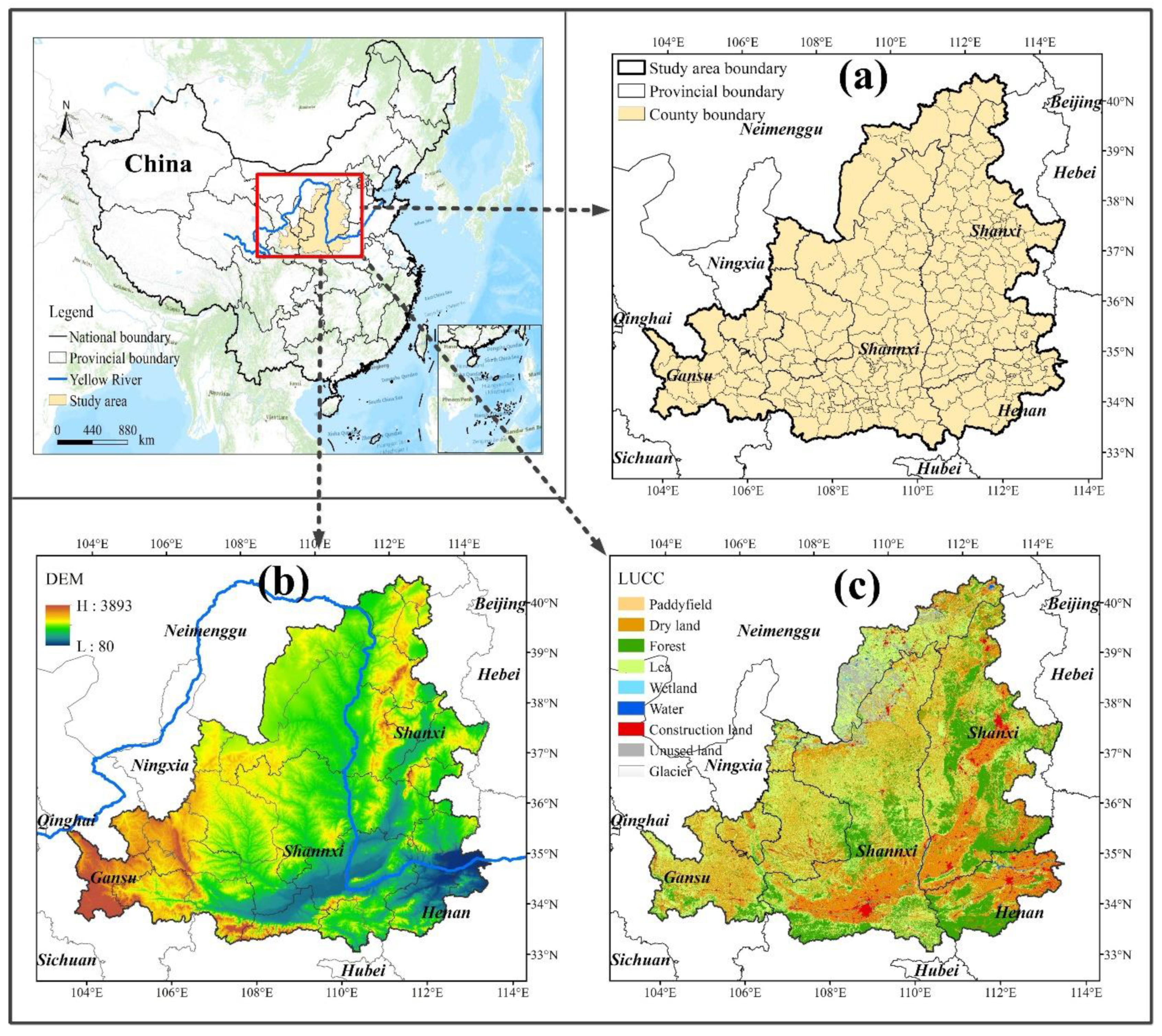
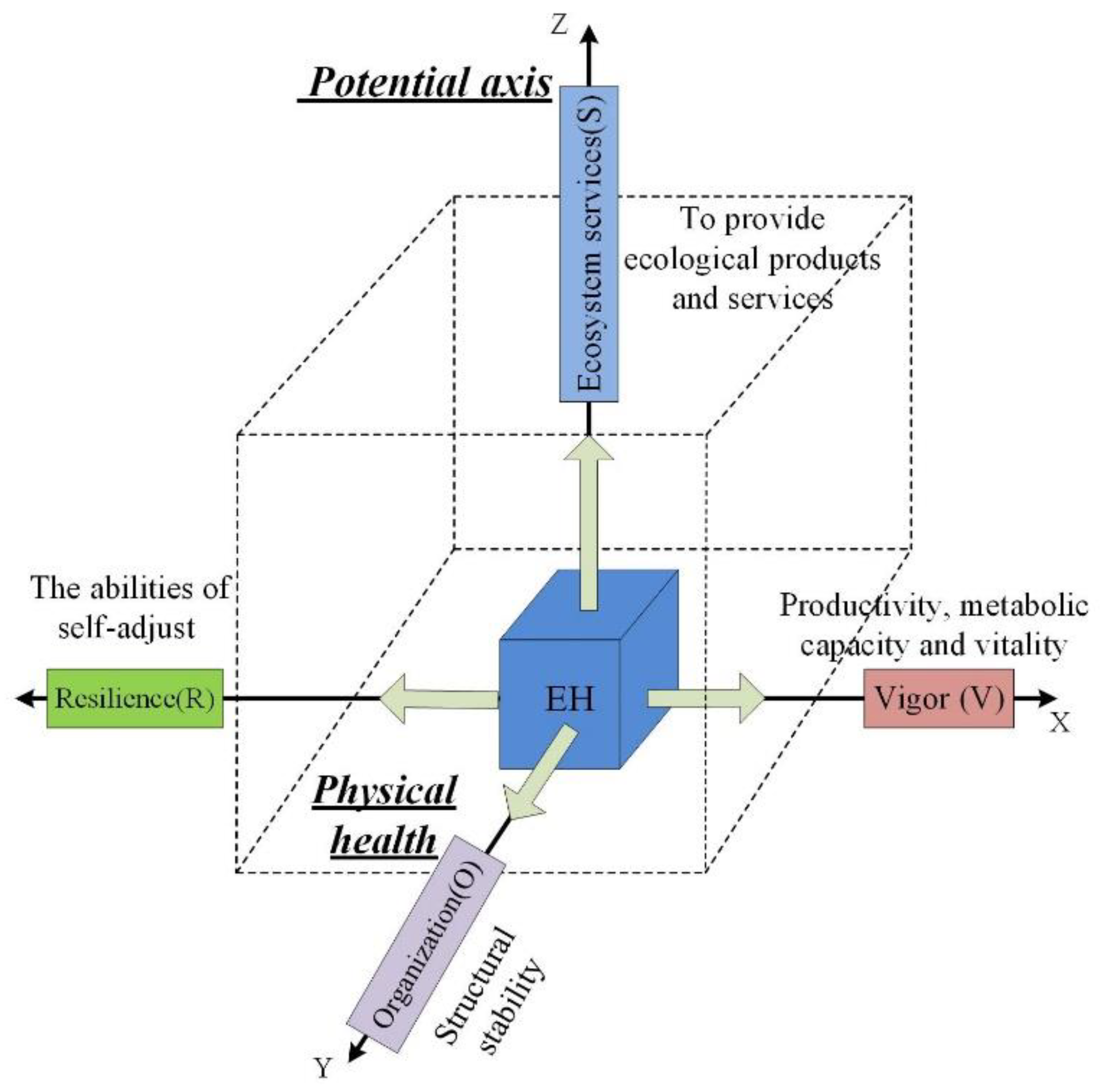
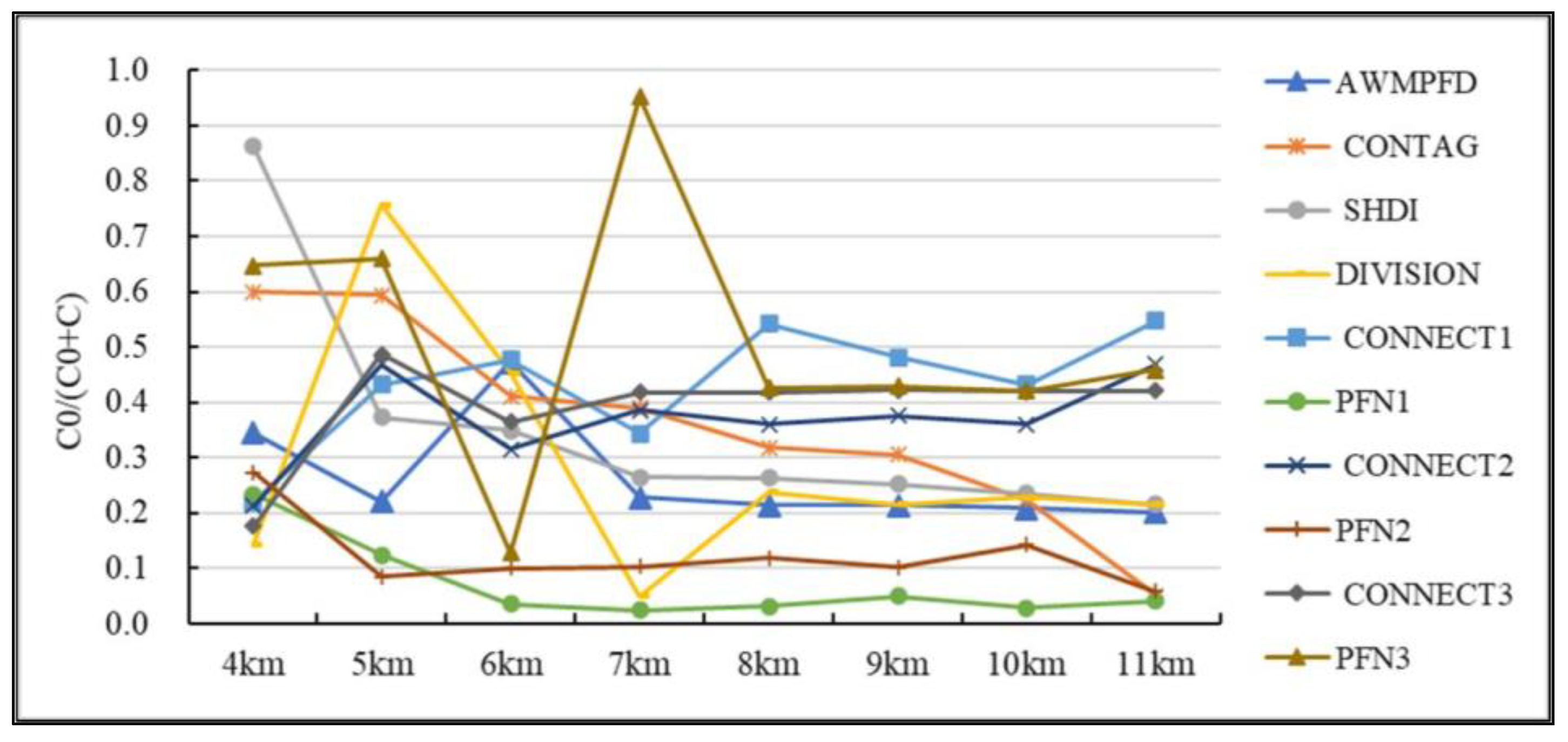


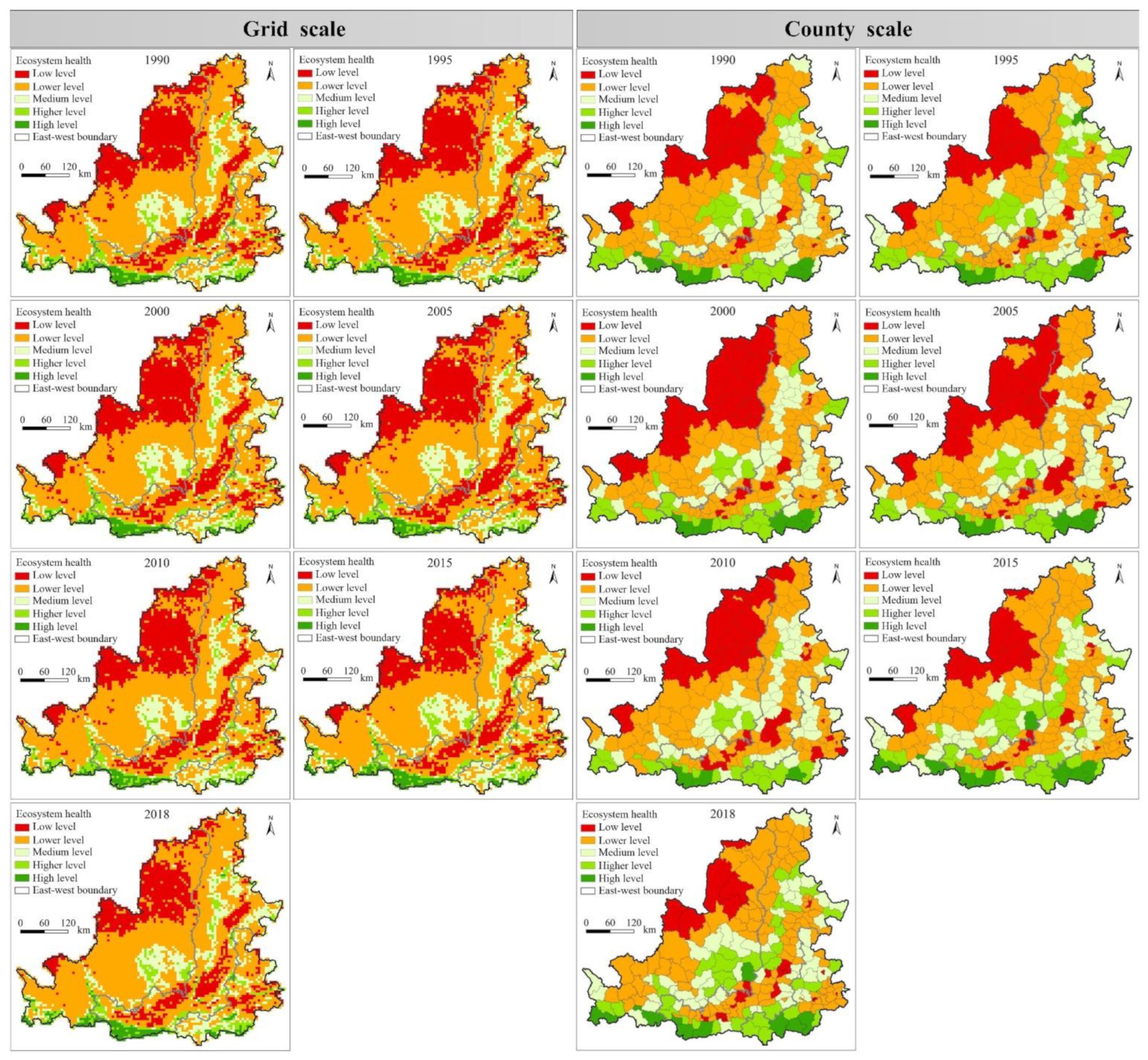
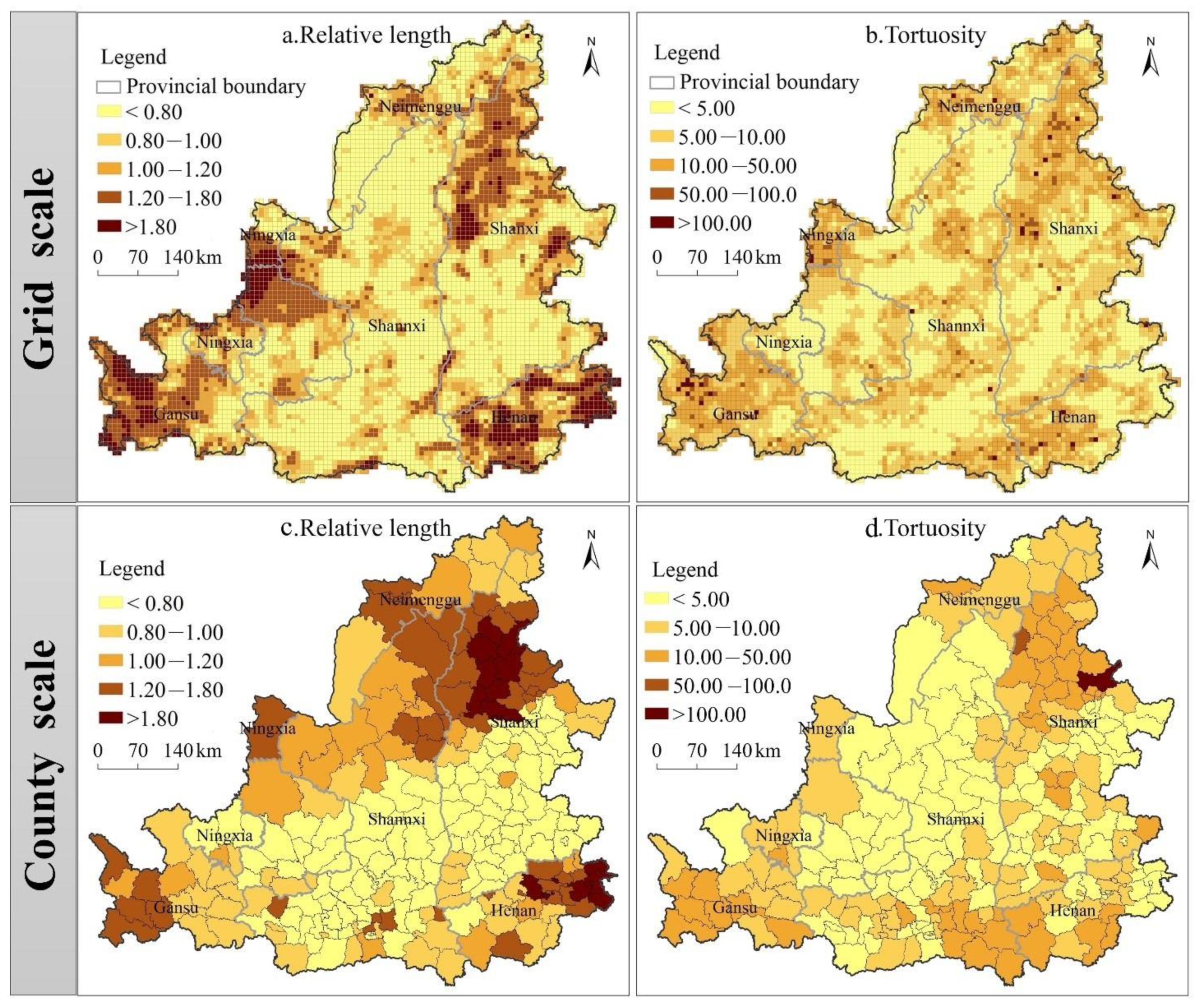
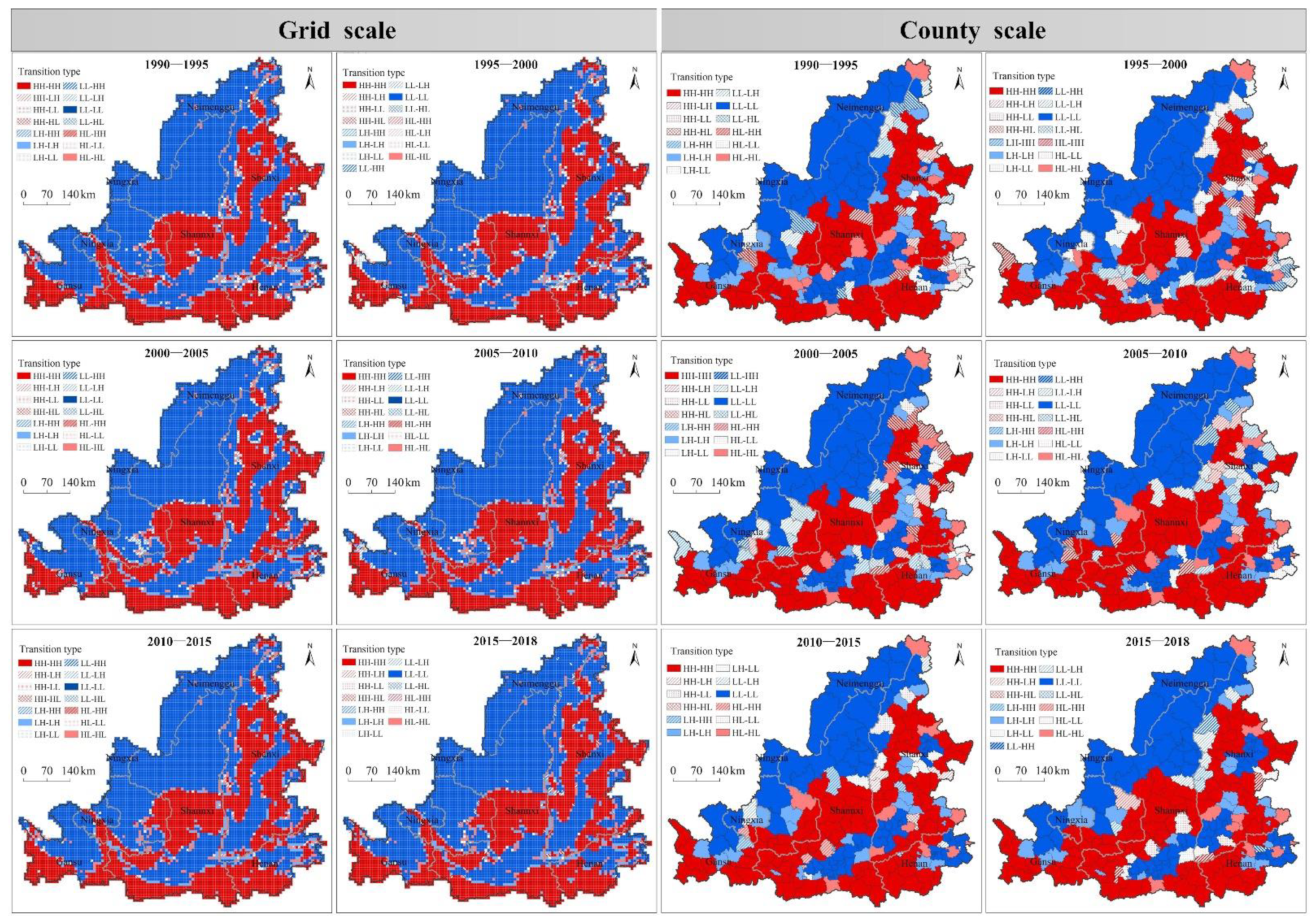
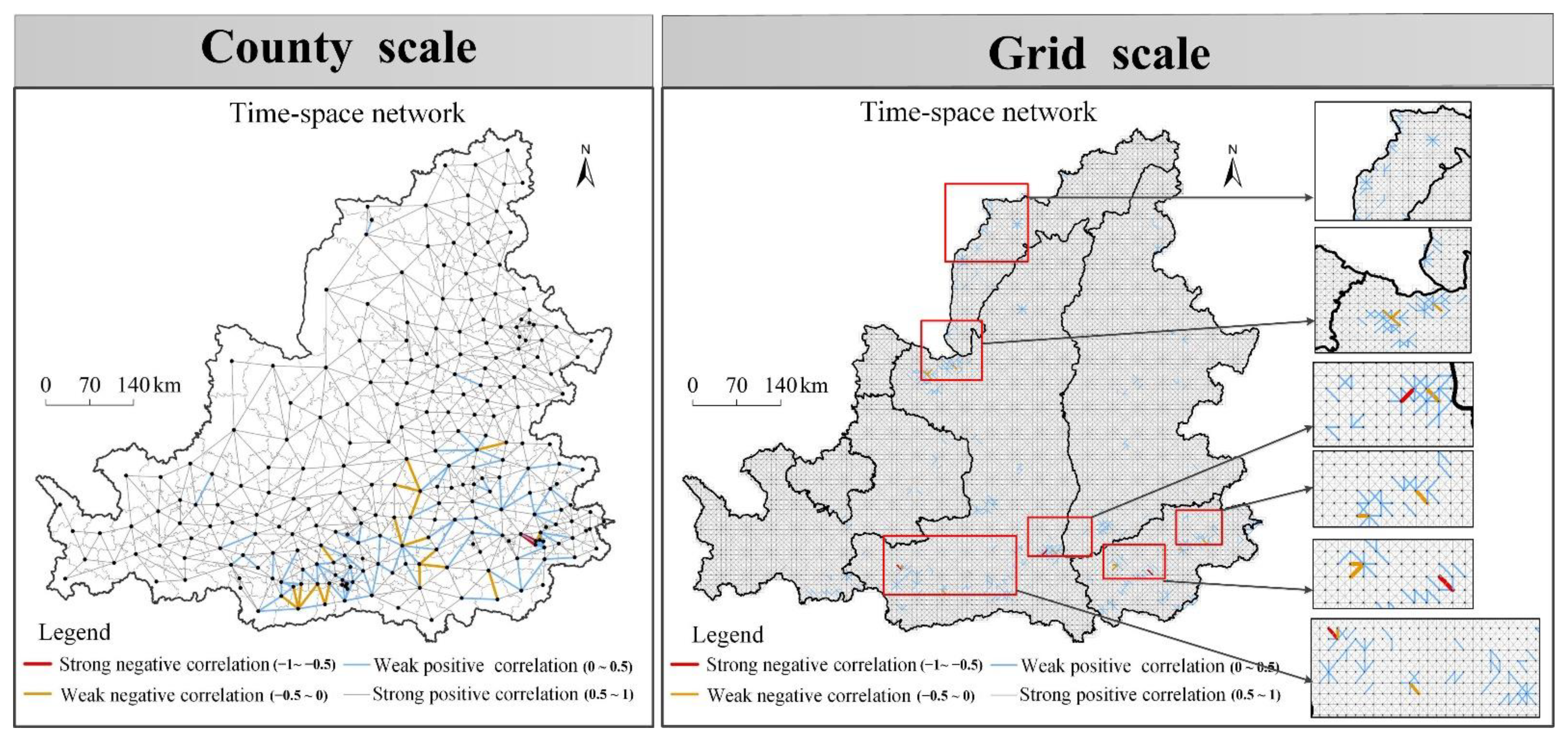
| Serial Number | Variable Name | Data Type/Resolution | Sources |
|---|---|---|---|
| 1 | Land use data | Raster data/30 m | http://www.resdc.cn, (accessed on 8 October 2022). |
| 2 | Normalized difference vegetation index | Raster data/250 m | http://www.resdc.cn, (accessed on 8 October 2022). |
| 3 | Annual precipitation | Raster data/1 km | http://www.geodata.cn, (accessed on 8 October 2022). |
| 4 | Annual average temperature | Raster data/1 km | http://www.geodata.cn, (accessed on 8 October 2022). |
| 5 | Meteorological station data | - | http://data.cma.cn, (accessed on 8 October 2022). |
| 6 | Net primary productivity | Raster data/5 km | http://www.geodata.cn, (accessed on 8 October 2022). |
| 7 | Elevation | Raster data/500 m | http://www.resdc.cn, (accessed on 8 October 2022). |
| 8 | Soil data | Raster data/30 m | http://westdc.westgis.ac.cn, (accessed on 8 October 2022). |
| Landscape Type | Paddy Field | Dry Land | Woodland | Grassland | Wetlands | Water | Construction Land | Unused | Glacier |
|---|---|---|---|---|---|---|---|---|---|
| Resistance | 0.6 | 0.5 | 1 | 0.7 | 0.6 | 0.8 | 0.3 | 0.2 | 0.1 |
| Resilience | 0.3 | 0.4 | 0.6 | 0.8 | 0.7 | 0.7 | 0.2 | 0.1 | 0.1 |
| Land Use Type of Adjacent Pixel | Land Use Type of Center Pixel | ||||||||
|---|---|---|---|---|---|---|---|---|---|
| Woodland | Grassland | Water | Paddy Field | Dry Land | Unused | Construction Land | Wetlands | Glacier | |
| Woodland | +5 | +5 | +5 | +5 | +4 | +4 | +4 | +5 | +3 |
| Grassland | +4 | +5 | +4 | +2 | +2 | +3 | +3 | +4 | +2 |
| Grassland | +5 | +4 | +5 | +4 | +2 | +4 | +4 | +4 | +1 |
| Paddy field | −1 | −1 | −5 | +4 | +2 | −1 | +1 | −2 | −1 |
| Dry land | −1 | −1 | −4 | +1 | +2 | −1 | +1 | −3 | −1 |
| unused | −1 | −2 | +5 | −3 | −3 | +1 | −1 | −3 | −1 |
| Construction land | −2 | −3 | −5 | +2 | +2 | −2 | +1 | −4 | −3 |
| Wetlands | +4 | +3 | +5 | +3 | +2 | +3 | +3 | +5 | +2 |
| glacier | −4 | −1 | −2 | −5 | −5 | −1 | −1 | −2 | +1 |
| 1990–1995 | t/t + 1 | HH | LH | LL | HL | Transition Type | Amount | Proportion | SF | SC |
| HH | 2388 | 31 | 3 | 37 | I | 6410 | 0.971 | 0.028 | 0.972 | |
| LH | 11 | 306 | 41 | 0 | II | 79 | 0.012 | |||
| LL | 4 | 19 | 3502 | 14 | III | 104 | 0.016 | |||
| HL | 7 | 0 | 23 | 214 | IV | 7 | 0.001 | |||
| 1995–2000 | t/t + 1 | HH | LH | LL | HL | Transition Type | Amount | Proportion | SF | SC |
| HH | 2367 | 21 | 11 | 11 | I | 6348 | 0.962 | 0.036 | 0.964 | |
| LH | 39 | 289 | 28 | 0 | II | 104 | 0.016 | |||
| LL | 3 | 53 | 3492 | 21 | III | 133 | 0.020 | |||
| HL | 41 | 1 | 23 | 200 | IV | 15 | 0.002 | |||
| 2000–2005 | t/t + 1 | HH | LH | LL | HL | Transition Type | Amount | Proportion | SF | SC |
| HH | 2389 | 26 | 5 | 30 | I | 6380 | 0.967 | 0.031 | 0.969 | |
| LH | 26 | 303 | 35 | 0 | II | 106 | 0.016 | |||
| LL | 8 | 27 | 3485 | 34 | III | 101 | 0.015 | |||
| HL | 9 | 0 | 20 | 203 | IV | 13 | 0.002 | |||
| 2005–2010 | t/t + 1 | HH | LH | LL | HL | Transition Type | Amount | Proportion | SF | SC |
| HH | 2410 | 12 | 1 | 10 | I | 6413 | 0.972 | 0.027 | 0.973 | |
| LH | 24 | 307 | 25 | 0 | II | 86 | 0.013 | |||
| LL | 7 | 34 | 3472 | 32 | III | 94 | 0.014 | |||
| HL | 25 | 0 | 18 | 224 | IV | 8 | 0.001 | |||
| 2010–2015 | t/t + 1 | HH | LH | LL | HL | Transition Type | Amount | Proportion | SF | SC |
| HH | 2451 | 8 | 2 | 5 | I | 6490 | 0.983 | 0.016 | 0.984 | |
| LH | 13 | 330 | 9 | 0 | II | 46 | 0.007 | |||
| LL | 1 | 26 | 3475 | 14 | III | 61 | 0.009 | |||
| HL | 21 | 0 | 11 | 234 | IV | 3 | 0.000 | |||
| 2015–2018 | t/t + 1 | HH | LH | LL | HL | Transition Type | Amount | Proportion | SF | SC |
| HH | 2458 | 10 | 1 | 17 | I | 6487 | 0.983 | 0.017 | 0.983 | |
| LH | 9 | 332 | 23 | 0 | II | 46 | 0.007 | |||
| LL | 0 | 18 | 3461 | 18 | III | 66 | 0.010 | |||
| HL | 8 | 0 | 9 | 236 | IV | 1 | 0.000 |
| 1990–1995 | t/t + 1 | HH | LH | LL | HL | Transition Type | Amount | Proportion | SF | SC |
| HH | 83 | 3 | 3 | 5 | I | 205 | 0.840 | 0.148 | 0.852 | |
| LH | 4 | 31 | 8 | 0 | II | 13 | 0.053 | |||
| LL | 0 | 8 | 78 | 4 | III | 23 | 0.094 | |||
| HL | 2 | 0 | 2 | 13 | IV | 3 | 0.012 | |||
| 1995–2000 | t/t + 1 | HH | LH | LL | HL | Transition Type | Amount | Proportion | SF | SC |
| HH | 77 | 4 | 4 | 4 | I | 190 | 0.779 | 0.201 | 0.799 | |
| LH | 5 | 26 | 11 | 0 | II | 19 | 0.078 | |||
| LL | 1 | 10 | 76 | 4 | III | 30 | 0.123 | |||
| HL | 5 | 0 | 6 | 11 | IV | 5 | 0.020 | |||
| 2000–2005 | t/t + 1 | HH | LH | LL | HL | Transition Type | Amount | Proportion | SF | SC |
| HH | 77 | 5 | 1 | 5 | I | 203 | 0.832 | 0.152 | 0.848 | |
| LH | 6 | 29 | 5 | 0 | II | 16 | 0.066 | |||
| LL | 3 | 6 | 85 | 3 | III | 21 | 0.086 | |||
| HL | 5 | 0 | 2 | 12 | IV | 4 | 0.016 | |||
| 2005–2010 | t/t + 1 | HH | LH | LL | HL | Transition Type | Amount | Proportion | SF | SC |
| HH | 84 | 3 | 1 | 3 | I | 205 | 0.840 | 0.148 | 0.852 | |
| LH | 8 | 26 | 6 | 0 | II | 14 | 0.057 | |||
| LL | 2 | 7 | 83 | 1 | III | 22 | 0.090 | |||
| HL | 6 | 0 | 2 | 12 | IV | 3 | 0.012 | |||
| 2010–2015 | t/t + 1 | HH | LH | LL | HL | Transition Type | Amount | Proportion | SF | SC |
| HH | 94 | 3 | 2 | 1 | I | 219 | 0.898 | 0.094 | 0.906 | |
| LH | 4 | 26 | 6 | 0 | II | 8 | 0.033 | |||
| LL | 0 | 4 | 88 | 0 | III | 15 | 0.061 | |||
| HL | 4 | 0 | 1 | 11 | IV | 2 | 0.008 | |||
| 2015–2018 | t/t + 1 | HH | LH | LL | HL | Transition Type | Amount | Proportion | SF | SC |
| HH | 95 | 3 | 0 | 4 | I | 222 | 0.910 | 0.086 | 0.914 | |
| LH | 3 | 26 | 4 | 0 | II | 8 | 0.033 | |||
| LL | 1 | 4 | 91 | 1 | III | 13 | 0.053 | |||
| HL | 1 | 0 | 1 | 10 | IV | 1 | 0.004 |
Publisher’s Note: MDPI stays neutral with regard to jurisdictional claims in published maps and institutional affiliations. |
© 2022 by the authors. Licensee MDPI, Basel, Switzerland. This article is an open access article distributed under the terms and conditions of the Creative Commons Attribution (CC BY) license (https://creativecommons.org/licenses/by/4.0/).
Share and Cite
Shen, W.; Li, Y. Multi-Scale Assessment and Spatio-Temporal Interaction Characteristics of Ecosystem Health in the Middle Reaches of the Yellow River of China. Int. J. Environ. Res. Public Health 2022, 19, 16144. https://doi.org/10.3390/ijerph192316144
Shen W, Li Y. Multi-Scale Assessment and Spatio-Temporal Interaction Characteristics of Ecosystem Health in the Middle Reaches of the Yellow River of China. International Journal of Environmental Research and Public Health. 2022; 19(23):16144. https://doi.org/10.3390/ijerph192316144
Chicago/Turabian StyleShen, Wei, and Yang Li. 2022. "Multi-Scale Assessment and Spatio-Temporal Interaction Characteristics of Ecosystem Health in the Middle Reaches of the Yellow River of China" International Journal of Environmental Research and Public Health 19, no. 23: 16144. https://doi.org/10.3390/ijerph192316144
APA StyleShen, W., & Li, Y. (2022). Multi-Scale Assessment and Spatio-Temporal Interaction Characteristics of Ecosystem Health in the Middle Reaches of the Yellow River of China. International Journal of Environmental Research and Public Health, 19(23), 16144. https://doi.org/10.3390/ijerph192316144






